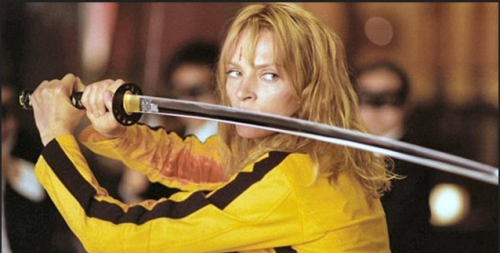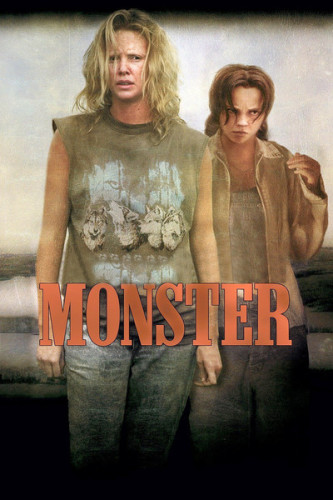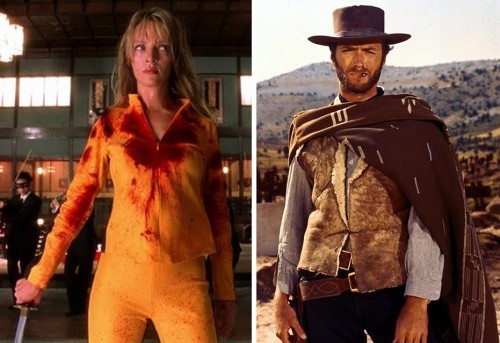This guest post by Katherine Fusciardi appears as part of our theme week on Violent Women.
Quentin Tarantino’s Kill Bill movies are often used in the discussion on the Rape Revenge genre of films. However, Kill Bill is actually one of the movies that falls under that genre, but doesn’t actually have much to do with rape revenge. Kill Bill’s “The Bride” character is an example of when other reasons for revenge are presented, when a woman is allowed to be violent for reasons other than seeking vengeance for a sexual assault. Aside from avenging her dead fiancé, the bride also seeks vengeance for the death of her child. Through further examination of well-liked violent female characters in popular media a pattern appears. Violent women can be loved as characters, as long as their reason for violence is sound in the mind of the viewer. Rape revenge is one of those acceptable reasons, another is the violent loss of a child.
As stated in Tammy Oler’s “The Brave Ones,”
“Kill Bill Vols. 1 and 2 and The Brave One are notable not just because they are among the most commercially successful films about revenge ever made, but also because they don’t use rape as their starting point” (Oler 34).
Beatrix Kiddo, “the bride,” makes it very clear that she is after revenge for her fiancé and child. When she confronts Vernita Green she claims she will not attack while Vernita is near her own child, but makes it clear she will still kill Vernita.
“No, to get even, even-Steven… I would have to kill you… go up to Nikki’s room, kill her… then wait for your husband, the good Dr. Bell, to come home and kill him. That would be even, Vernita. That’d be about square” (Kill Bill).
Beatrix goes back on this promise when Vernita attacks, resulting in Vernita’s daughter witnessing the whole incident. Given that this is the first fight the viewer sees Beatrix in, it shapes her character. Beatrix’s response to the situation shows how cold she can be expected to be. She tells the little girl,
“It was not my intention to do this in front of you. For that I’m sorry. But you can take my word for it, your mother had it coming. When you grow up, if you still feel raw about it, I’ll be waiting” (Kill Bill).
With that amount of motivation behind Beatrix’s revenge, the rationale for her violence should be covered. However, even Oler’s article admitted that despite the different reasons for revenge presented, there is still a sexualizing to that female character, such as the rape seen in the first Kill Bill movie, in which Beatrix wakes up from her coma to find that she has been raped repeatedly in her sleep. Tammy Oler questioned whether that was necessary or not:
“Is it because it heightens the sense of victimization or because we believe that rape, real or otherwise, is the only believable crime that prompts women to such anger and violence?” (Oler 34)
A proper response to that question can be found by delving into other popular violent female characters, such as Carol and Michonne from the hit AMC television series The Walking Dead. In the beginning of the series the viewers are introduced to Carol Peletier, a housewife trying to survive the zombie apocalypse with her abusive husband and their daughter Sophia. When the abusive husband dies in season one there is the expectation that Carol will be able to develop more as a character without her husband around to push her back down. However, that development doesn’t happen. It isn’t until her daughter dies in season two that the viewer sees any change in Carol’s character.
At the beginning of season two, Sophia, Carol’s daughter, goes missing after a “walker” (zombie) attack. Sophia is not confirmed dead until she is found as a walker at the end of season two, episode seven: “Pretty Much Dead Already.” In episode eight, “Nebraska” Carol says,
“That’s not my little girl. It’s some other… thing. My Sophia was lost in the woods. All this time, I thought. But she didn’t go hungry. She didn’t cry herself to sleep. She didn’t try to find her way back. Sophia died a long time ago” (The Walking Dead S2EP8)
when asked to attend her child’s funeral. This attitude is the first indication of the transformation Carol will undergo.
In season four of The Walking Dead Carol is asked to take two girls, Lizzie and Mika, under her protection by their dying father. As part of their education the girls are required to learn the proper way to kill walkers and are instructed to never call Carol “Mom.” When asked by Lizzie why Carol’s daughter wasn’t there anymore Carol responds “She didn’t have a mean bone in her body” (The Walking Dead S4EP14) and insists that the girls learn a lesson from that, which is to do whatever it takes to survive; kill walkers and kill people. Killing people is something Carol had recently come to terms with, killing two influenza infected members of their group to protect the rest.
When it becomes apparent Lizzie has become mentally disturbed, and refuses to kill walkers because she believes they are good, Carol labels Lizzie as weak and begins grooming Mika, the younger sister, to be the tougher survivor. However, in that same episode, Lizzie murders her little sister in order to turn her into a walker. Once Carol realizes Lizzie will never be able to live among people again, Carol shoots Lizzie and never speaks about either girl ever again.
Though out the series the viewers are also introduced to a new character, Michonne. Michonne is a katana wielding woman that instantly became a show favorite. When Michonne was introduced into the series in season three she was accompanied by two jawless, armless walkers kept chained to her person. Later in the season she reveals that the two walkers were her boyfriend and his friend. Her boyfriend was also the father of her child, which died after the apocalypse began. She blamed those two men, whom she found undead along with the child in their camp, for the death of her son. When telling the story of her son’s death, Michonne describes going on a supply run and returning to her camp only to find her son dead and both men bitten. “They were high when it happened,” she said, “And they were bit. I could have stopped it, could of killed them, but I let them turn” (The Walking Dead, S4EP16). To punish them, and herself, even after death she mutilated their walker bodies so they would no longer be a threat and kept them chained to her at all times. This was her way of ensuring that neither of the men would find rest. “It was insane. It was sick. It felt like what I deserved” (S4EP16).
The popularity of these characters shows that the masses can accept the motivation of violent women for more than rape revenge. So, why is rape revenge is still considered the go-to reason for female violence? In a paper written and presented by Ruby Tapia at the Visual Culture Gathering, the issues of race and feminism as they relate to Kill Bill are discussed. The paper uses quotes from Quentin Tarantino to explain his motivation. As stated earlier, the rape scene in Kill Bill changes the motivation of the character and introduces rape-revenge as a fall back reasoning for Beatrix’s violence. To Tarantino it was his way of addressing issues he saw n society:
“Once I got this idea in my mind, I couldn’t get it out. It would be a lot easier if I didn’t go down that road, but then that would be cowardice to me. Because there have been reports about, you know, comatose patients being raped” (Ruby Tapia, Quentin Tarantino 33).
The conversation continues with Tarantino describing an obsession with the idea, and described it as the spice that would get viewers addicted to his film. To which Tapia had to say, “Thus, buried so deep inside the filmic narrative as Tarantino might suggest, is the rape fantasy turned real” (34).
Taken straight from Tarantino, we can see that the rape scene was never meant to be a factor into Beatrix’s motivation. It was simply thrown in out of Tarantino’s whim, as both a nod to feminism and a lure for his movie. With that in mind, it means the rape scene has zero meaning to the plot. Rape revenge has nothing to do with Kill Bill, outside of that one scene.
Rape revenge ceases to the only viable motivation for violent women when these three popular characters are analyzed. Beatrix Kiddo was not seeking revenge for her rape, she was seeking revenge for her fiancé and child. From The Walking Dead, neither Carol nor Michonne was raped. They became violent following the violent losses of their children. The reasoning behind the violent acts committed by these women does bring to mind a different issue. True, the rape revenge trope has been put at bay, but there is still a gender issue behind the remaining motivation. It focuses around the assumption of maternity being the all-encompassing passion. Until female characters can be violent for reasons that have nothing to do with their womanhood, there still isn’t complete equality in media.
Works Cited
Oler, Tammy. “The Brave Ones.” Bitch Magazine: Feminist Response to Pop Culture Winter, 2009, 30-34. Print.
Kill Bill Vol. 1. Dir. Quentin Tarantino. Perf. Uma Thurman, David Carradine. Miramax Films, 2003 DVD.
Tapia, Ruby. “Volumes of Transnational Vengeance: Fixing Race and Feminism on the Way to Kill Bill.” Visual Arts Research Vol. 32. No 2 (2006): 32-37. Print.
“Nebraska.” The Walking Dead Season Two. Exec. Producer Frank Durabont. Perf. Mellissa McBride. AMC, 2011. DVD.
“A.” The Walking Dead Season Four. Exec. Producer Frank Durabont. Perf. Danai Gurira. AMC, 2013. DVD.
Katherine Fusciardi is a senior in the English program at Kutztown University of Pennsylvania. Katherine created the student organization known as SCAR (Student Campaign Against Rape) and is currently using her position as president to increase awareness, action, and support on her campus.



















